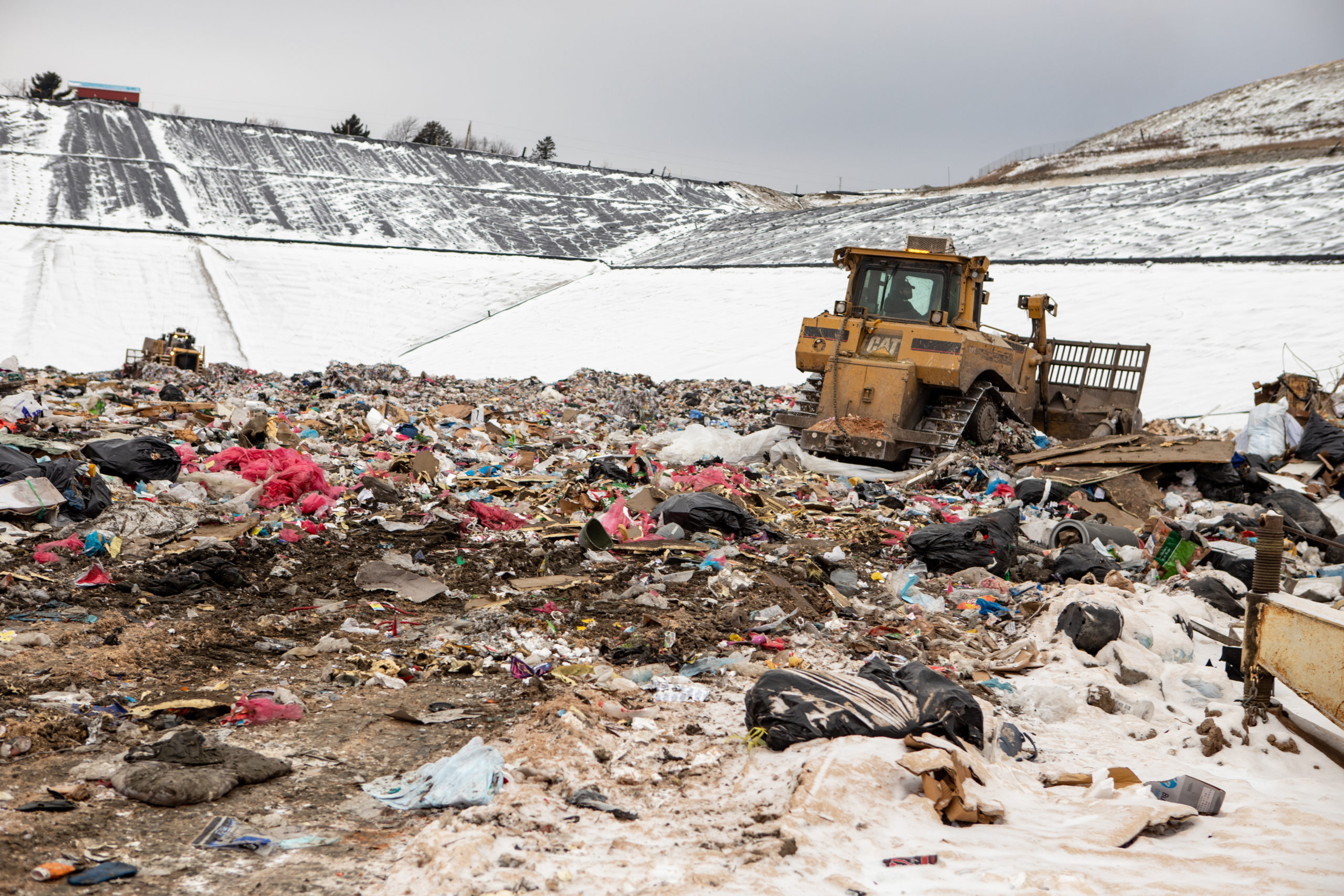A plow scoops garbage at Vermont’s only operating landfill, a Casella Waste Systems facility in Coventry. File photo by Riley Robinson/VTDigger
In the aftermath of last summer’s devastating floods, Casella, the company that owns Vermont’s only operating landfill, accepted debris from demolished buildings, including a large amount of drywall and plaster.
According to Casella, that material has produced sulfur dioxide emissions that exceed the Coventry landfill’s air quality standards outlined in its state permit. While the pollutants surpassed the facility’s permitted limit in March, April and May, according to the state Agency of Natural Resources, Casella said the emissions have stayed within federal standards and do not immediately pose a significant risk to the public. The company is working to install a permanent treatment system that is designed to reduce the emissions.
Sulfur dioxide, a pollutant that is also commonly emitted during the burning of fossil fuels, can cause respiratory problems. People with existing respiratory conditions such as asthma, especially children, are most vulnerable, according to the federal Environmental Protection Agency.
Drywall and plaster are mostly composed of calcium sulfate and “made up a significant portion of the tens of thousands of tons of waste” that the landfill accepted after the flood, according to a recent press release issued by Casella. Once in the landfill, the material changes the composition of the gases that the landfill typically creates, producing hydrogen sulfide, which can result in elevated levels of sulfur dioxide.
The gases created by the landfill are pulled into a collection system and combusted to create energy for Washington Electric Cooperative. That combustion process is where the sulfur dioxide enters the atmosphere, according to Jeff Weld, a spokesperson for Casella.
At high concentrations, sulfur dioxide and other similar compounds can cause environmental harm, such as damaging the foliage of trees and plants and stunting their growth, according to the EPA.
The state standard for the landfill’s sulfur dioxide emissions is 40 tons per year — much stricter than the federal standard, which is 250 tons per year, according to Weld. The federal standard “provides public health protection,” Jay Hollingsworth, who supervises the permitting and engineering section of the Agency of Natural Resources’ Air Quality & Climate Division, told VTDigger in an email.
The Coventry landfill has not exceeded those federal standards for sulfur dioxide, according to Weld.
“I wouldn’t call it a cause for major concern, but it is a cause for awareness of why it’s important to have a strong approach in terms of collecting the material, sequestering it and really understanding what that makeup is,” Weld said.
Casella measures the levels of hydrogen sulfide on a monthly basis using detection tubes. Then, they estimate sulfur dioxide levels based on the hydrogen sulfide concentrations.
While Casella works to implement its new treatment system, it is using an activated carbon system designed to reduce hydrogen sulfide levels in the gas stream, thereby lowering the sulfur dioxide levels, Weld said.
The measures Casella has taken have “begun reducing the associated sulfur dioxide emissions,” according to Hollingsworth.
According to Weld, the measures “have resulted in a sitewide month over month reduction of (hydrogen sulfide) by nearly half.”
Prior flood events have shown the Agency of Natural Resources and the Environmental Protection Agency that peak hydrogen sulfide and sulfur dioxide emissions could materialize more than a year after the flood, according to Casella. Officials saw the same pattern at the Moretown Landfill after Hurricane Irene.
With that knowledge, Weld said staff members at Casella proactively met with state and federal agencies in September to develop a plan.
Weld said the company decided to issue a press release to “educate the public without alarm.”
“To us, it was important to be out in front and say, ‘Hey, we’re working on this with ANR. We understand why it’s occurring,’” Weld said.
Climate change continues to cause natural disasters that result in more debris, a factor that Weld said should be considered in long-term planning.
“It’s one of those things that we see with events like this,” he said. “As they become more likely to happen, now and in the future, it’s got to be part of how we permit these facilities, how we think about installing new equipment to treat for that sort of thing.”
Read the story on VTDigger here: Flood debris causes air quality problems at Coventry landfill.

